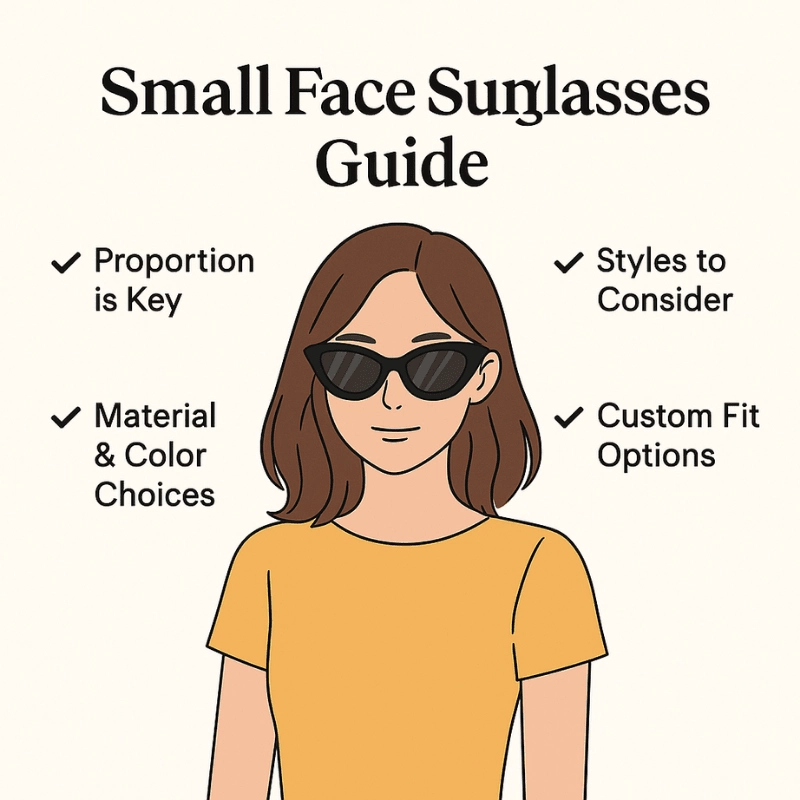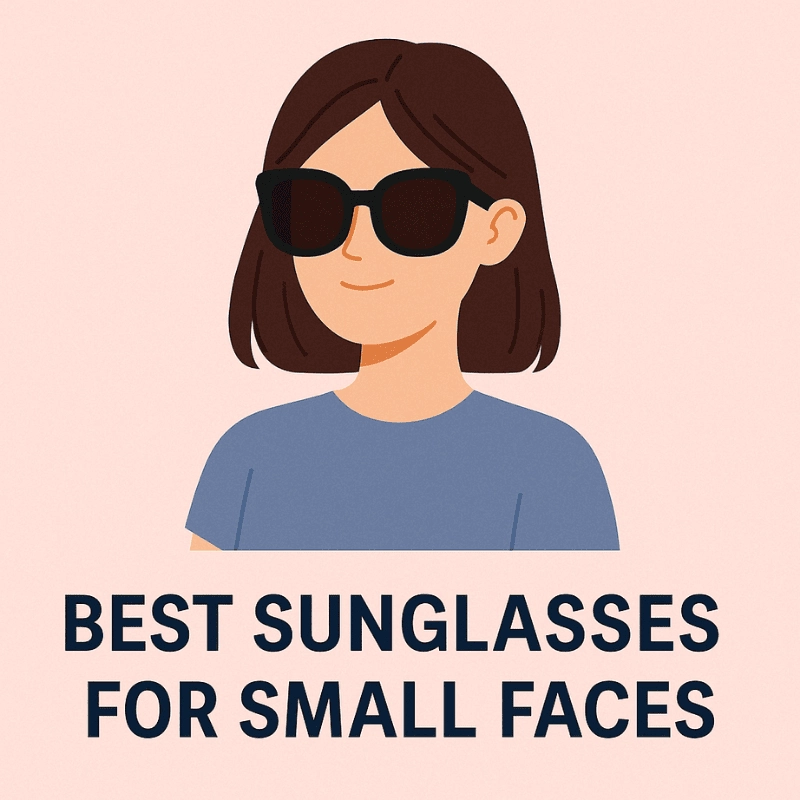A comprehensive guide to finding the perfect sunglasses for petite facial features through proper material selection and style considerations.
Picture this: You walk into a sunglasses store excited to find your perfect pair, only to discover that every frame makes your delicate features disappear or look disproportionate. Sound familiar? Here’s the reality – most sunglasses are designed for average or larger face shapes, leaving those with petite features struggling to find flattering options. But here’s the good news: with the right material choices and style knowledge, you can find small face sunglasses that enhance your natural beauty while providing optimal protection.

1. Why Do Small Face Sunglasses Require Special Material Considerations?
Small face sunglasses demand unique material properties that differ significantly from standard eyewear. Here’s why: lightweight materials prevent sliding while maintaining structural integrity.
Can Lighter Materials Really Make a Difference?
The science behind this is fascinating. Petite facial features require proportionally balanced accessories that won’t overwhelm delicate bone structure. Heavy materials create pressure points and cause constant readjustment throughout the day.
- Titanium offers 40% less weight than traditional metals
- Acetate provides flexibility without bulk
- High-grade plastics maintain durability at minimal weight
What Problems Do Heavy Materials Cause?
You might be wondering about specific issues that arise with inappropriate material choices. Excessive weight leads to nose bridge impressions, temple pressure, and frequent slippage during activities.
Key Takeaway:
Material selection directly impacts comfort and aesthetic appeal, making it the foundation of successful small face sunglasses design.
| Material Property | Impact on Small Faces | Recommended Level |
|---|---|---|
| Weight | High | Under 25 grams |
| Flexibility | Medium | Moderate bend |
| Durability | High | 5+ years |
2. What Frame Materials Work Best for Small Face Sunglasses?
Premium frame materials for small face sunglasses prioritize weight reduction without compromising strength.
Are Titanium Frames Worth the Investment?
Titanium frames offer unmatched benefits for small faces despite higher costs. This hypoallergenic material resists corrosion while maintaining elegant thin profiles.
- Corrosion resistance lasts 10+ years
- Hypoallergenic properties prevent skin reactions
- Ultra-thin profiles create sophisticated aesthetics
How Does Acetate Compare for Small Face Sunglasses?
High-quality acetate provides excellent customization options through varied colors and patterns while maintaining appropriate proportions for smaller features.
Key Takeaway:
Frame material choice determines both immediate comfort and long-term satisfaction.
| Frame Material | Weight (g) | Durability | Price Range |
|---|---|---|---|
| Titanium | 18–22 | Excellent | $200–500 |
| Acetate | 20–28 | Very Good | $100–350 |
| Stainless Steel | 25–35 | Good | $80–200 |
3. How Do Lens Materials Impact Small Face Sunglasses Performance?
Lens material selection dramatically affects both visual clarity and weight distribution.
What Makes Polycarbonate Ideal for Small Faces?
Polycarbonate lenses provide impact resistance while weighing 40% less than traditional glass.
- Impact resistance exceeds safety standards
- UV protection blocks 99.9% harmful rays
- Scratch-resistant coatings extend lifespan
Do Glass Lenses Have Any Advantages?
While heavier, premium glass offers superior optical clarity for those prioritizing visual performance over weight.
Key Takeaway:
Lens material directly influences both protection quality and wearing comfort.
| Lens Material | Weight Impact | Clarity Rating | Durability Score |
|---|---|---|---|
| Polycarbonate | Low | Very Good | Excellent |
| CR-39 Plastic | Medium | Good | Good |
| Glass | High | Excellent | Fair |
4. Which Nose Bridge Materials Ensure Comfort?
Nose bridge materials significantly impact fit stability.
Why Do Silicone Nose Pads Excel?
Medical-grade silicone nose pads adapt to individual nose shapes while providing non-slip grip without irritation.
- Medical-grade silicone prevents allergic reactions
- Self-adjusting properties accommodate swelling
- Easy cleaning maintains hygiene
How Do Integrated Bridge Designs Compare?
Integrated acetate or titanium bridges eliminate pressure points while creating seamless aesthetics.
Key Takeaway:
Proper nose bridge material selection ensures day-long comfort.
| Bridge Material | Comfort | Adjustability | Maintenance |
|---|---|---|---|
| Silicone Pads | Excellent | High | Simple |
| Integrated Acetate | Very Good | Low | Minimal |
| Metal Saddle | Good | Medium | Regular |
5. What Temple Materials Provide Optimal Fit?
Temple material selection determines stability and comfort during movement.
Do Memory Metal Temples Work Better?
Memory metal temples adjust to head shape while maintaining consistent pressure distribution.
- Shape memory returns to original form
- Consistent pressure prevents headaches
- Durable under repeated flex
How Important Is Temple Tip Material?
Temple tips affect comfort and security — rubber or silicone tips provide grip without irritation.
Key Takeaway:
Temple materials directly impact wearing security and comfort.
| Temple Feature | Comfort | Durability | Grip Level |
|---|---|---|---|
| Memory Metal | Excellent | High | Medium |
| Flexible Acetate | Very Good | Medium | Low |
| Rubber Tips | Good | Medium | High |
6. How Do Color and Finish Materials Affect Appearance?
Color and finish significantly influence how sunglasses complement small facial features.
Which Colors Enhance Small Faces?
Warm tones and softer finishes create balance, while bold contrasts may overwhelm delicate features.
- Tortoiseshell adds sophistication
- Matte finishes reduce glare
- Gradient colors add proportionate interest
How Do Metallic Finishes Impact Appearance?
Brushed and satin metallic finishes provide elegance without harsh reflections.
Key Takeaway:
Thoughtful color and finish selection enhances natural beauty.
| Finish Type | Enhancement Level | Versatility | Maintenance Needs |
|---|---|---|---|
| Matte | High | Excellent | Low |
| Satin Metal | Very Good | Good | Medium |
| High Gloss | Medium | Fair | High |
7. What Sizing Specifications Should You Consider?
Precise sizing ensures optimal fit and proportion.
What Lens Width Works Best?
Lens width between 45–52mm typically provides ideal coverage without overwhelming small features.
- 45–48mm suits very small faces
- 49–52mm fits small to medium features
- Bridge width: 14–18mm for proper fit
How Important Is Overall Frame Width?
Frame width should not exceed temple-to-temple measurement plus 5mm.
Key Takeaway:
Accurate sizing prevents fit issues and ensures proper UV coverage.
| Measurement | Small Face Range | Standard Range | Difference |
|---|---|---|---|
| Lens Width | 45–52mm | 50–60mm | –8mm avg |
| Bridge Width | 14–18mm | 16–22mm | –3mm avg |
| Temple Length | 135–145mm | 140–150mm | –5mm avg |
8. Which Brands Excel in Small Face Designs?
Certain brands are known for creating options tailored to petite faces.
Do Luxury Brands Offer Better Options?
Premium brands invest in R\&D for niche markets, delivering superior fit and materials.
- Ray‑Ban: Junior & Small Face collections
- Oakley: Women-specific proportions
- Maui Jim: Petite frame options
How About Independent Designers?
Boutique designers often specialize in small face designs with unique materials.
Key Takeaway:
Brand choice significantly impacts material quality and fit precision.
| Brand Category | Material Quality | Fit Options | Price Range |
|---|---|---|---|
| Luxury | Excellent | Extensive | $300–800 |
| Premium | Very Good | Good | $150–400 |
| Independent | Variable | Unique | $200–600 |
9. How Do You Maintain Different Materials?
Proper maintenance extends lifespan and appearance.
What Cleaning Methods Work Best?
Use microfiber cloths and pH-neutral cleaners to protect delicate coatings.
- Daily cleaning prevents buildup
- Proper storage maintains shape
- Professional maintenance extends life
How Do You Protect Different Materials?
Each material requires specific care to prevent premature wear.
Key Takeaway:
Consistent maintenance ensures longevity.
| Material Type | Cleaning Frequency | Storage Method | Lifespan |
|---|---|---|---|
| Titanium | Daily | Hard case | 8–10 years |
| Acetate | 2–3 times weekly | Soft case | 5–7 years |
| Plastic | Daily | Protective pouch | 3–5 years |
10. What Future Innovations Await?
Emerging materials promise to improve design and performance.
Will Smart Materials Change Everything?
Shape‑memory alloys and adaptive materials will adjust fit dynamically.
- Self‑adjusting frames
- Photochromic materials
- Antimicrobial coatings
How Will Sustainability Play a Role?
Bioplastic and recycled composites are becoming performance-competitive and eco-friendly.
Key Takeaway:
Future innovations will resolve current limitations while enabling customization and sustainability.
| Innovation Type | Timeline | Expected Benefits |
|---|---|---|
| Smart Materials | 2–3 years | Auto‑adjustment |
| Bio‑plastics | 1–2 years | Sustainability |
| Nano‑coatings | 6 months | Enhanced durability |

Conclusion
Material and style selection for small face sunglasses requires understanding the unique challenges and opportunities presented by petite facial features. The bottom line is this – proper material choices transform potentially frustrating shopping experiences into successful investments in both style and comfort.
What we’ve covered today addresses every aspect of material selection from frame construction to lens technology, proving that small faces deserve specialized attention in eyewear design. Here’s what you can do next – use this comprehensive guide to evaluate current options and make informed decisions based on your specific needs and lifestyle requirements.
Our commitment remains clear: every person deserves sunglasses that enhance their natural beauty while providing optimal protection, regardless of face size. The future of small face sunglasses lies in continued innovation and specialized design attention.
Frequently Asked Questions
Q1: Can I wear regular sunglasses if I have a small face?
You can, but they may not fit properly, causing slippage or pressure.
Q2: What’s the best frame material for sensitive skin?
Titanium is best; medical-grade acetate is a close alternative.
Q3: How do I know if frames are too big?
If they extend past your temples or slip often, they’re too large.
Q4: Can I modify regular sunglasses to fit better?
Minor adjustments are possible, but major changes may affect integrity.
Q5: What’s the difference between men’s and women’s small face sunglasses?
Mainly color and style differences; dimensions and materials are similar.

